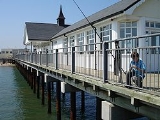
Southwold Pier
Encyclopedia
Southwold Pier is a pier
in Southwold
, Suffolk
, East Anglia
, England
.
Whilst many English seaside piers are in decline, Southwold Pier is enjoying renewed popularity. It includes a collection of modern coin-operated novelty machines designed and constructed by the inventor Tim Hunkin
.
A major refurbishment program was started in 1999 in order to rebuild the pier. This was completed in 2001 almost 100 years after it was first opened. In 2002 the T-Shaped end was additionally added, bringing the pier to a total length of 623 feet (189.9 m). This additional length now allows the pier to accommodate visits by Britain's only surviving sea-going steam passenger ship
, the PS Waverley
paddle steamer and its sister ship the M.V.Balmoral.
Pier
A pier is a raised structure, including bridge and building supports and walkways, over water, typically supported by widely spread piles or pillars...
in Southwold
Southwold
Southwold is a town on the North Sea coast, in the Waveney district of the English county of Suffolk. It is located on the North Sea coast at the mouth of the River Blyth within the Suffolk Coast and Heaths Area of Outstanding Natural Beauty. The town is around south of Lowestoft and north-east...
, Suffolk
Suffolk
Suffolk is a non-metropolitan county of historic origin in East Anglia, England. It has borders with Norfolk to the north, Cambridgeshire to the west and Essex to the south. The North Sea lies to the east...
, East Anglia
East Anglia
East Anglia is a traditional name for a region of eastern England, named after an ancient Anglo-Saxon kingdom, the Kingdom of the East Angles. The Angles took their name from their homeland Angeln, in northern Germany. East Anglia initially consisted of Norfolk and Suffolk, but upon the marriage of...
, England
England
England is a country that is part of the United Kingdom. It shares land borders with Scotland to the north and Wales to the west; the Irish Sea is to the north west, the Celtic Sea to the south west, with the North Sea to the east and the English Channel to the south separating it from continental...
.
Whilst many English seaside piers are in decline, Southwold Pier is enjoying renewed popularity. It includes a collection of modern coin-operated novelty machines designed and constructed by the inventor Tim Hunkin
Tim Hunkin
Tim Hunkin is an English engineer, cartoonist, writer, and artist living in Suffolk, England. He is best known for creating the Channel Four television series The Secret Life of Machines, in which he explains the workings and history of various household devices...
.
History
The pier was built in 1900, when it extended for a distance of 810 feet (246.9 m) and finishing with a T-shaped end. The pier end was practically destroyed by a gale in 1934, with the T-shaped end being swept away. A series of events during the Second World War and a further major storm in 1979 reduced the pier to approximately 100 feet (30.5 m).Restoration
The pier was bought by Chris Iredale in 1987 and he first spent five years turning the pavilion into a profit-making business.A major refurbishment program was started in 1999 in order to rebuild the pier. This was completed in 2001 almost 100 years after it was first opened. In 2002 the T-Shaped end was additionally added, bringing the pier to a total length of 623 feet (189.9 m). This additional length now allows the pier to accommodate visits by Britain's only surviving sea-going steam passenger ship
Steamboat
A steamboat or steamship, sometimes called a steamer, is a ship in which the primary method of propulsion is steam power, typically driving propellers or paddlewheels...
, the PS Waverley
PS Waverley
PS Waverley is the last seagoing passenger carrying paddle steamer in the world. Built in 1946, she sailed from Craigendoran on the Firth of Clyde to Arrochar on Loch Long until 1973...
paddle steamer and its sister ship the M.V.Balmoral.

